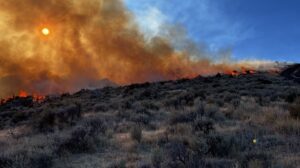Smoke
Event webpage
NTFAQ 2025 will be May 19-22 at Harrah’s Resort in southern CA (777 S. Resort Dr. Valley, CA 92082)
View article.
Rural residents think of smoke as an acceptable risk. Efforts to adapt to potential health impacts are minimal, though inaction is driven by diverse reasoning and tradeoffs. Local social context particularly elements related to government distrust, forest management, and independence – heavily influences interest in uptake of different adaptation strategies as well as affecting access to, and interpretation of, information about smoke risks. Rural approaches to, and understandings of, smoke adaptation vary spatially and temporally. Public interest in broader forest management efforts can be leveraged to engage residents in conversations about proactive smoke adaptation. Implications. Smoke adaptation strategies in rural communities must meld evidence of their effectiveness with community preferences grounded in local context to overcome inaction.
View article.
We sought to determine the role of local social context in smoke adaptation and gauge interest in adaptation strategies that might reduce exposure. We conducted 46 semi-structured interviews with 56 residents and professionals in Parks, Arizona, USA, a rural community adjacent to public lands regularly affected by smoke. Rural residents think of smoke as an acceptable risk. Efforts to adapt to potential health impacts are minimal, though inaction is driven by diverse reasoning and tradeoffs. Local social context – particularly elements related to government distrust, forest management, and independence – heavily influences interest in uptake of different adaptation strategies as well as affecting access to, and interpretation of, information about smoke risks. Rural approaches to, and understandings of, smoke adaptation vary spatially and temporally. Public interest in broader forest management efforts can be leveraged to engage residents in conversations about proactive smoke adaptation.
View synthesis.
Fire is an integral component of many Southwest ecosystems; however, fire regimes across the region have been affected by climate change, creating conditions to which these ecosystems have not adapted. Since 1980, fire frequency, size and severity have increased in many ecosystems in the western US due to changes in climate combined with a history of fire suppression and other forest management practices, such as grazing and logging…
…The goal of this synthesis is to provide a summary of the literature, published in 2023, on fire and fire-related topics
Learn more about FASMEE in this video (8:26).
Fire and smoke researchers collaborated with land managers to “learn and burn” from a unique, high-intensity prescribed fire that was conducted to restore aspen forests on the Fishlake National Forest in southern Utah. Led by the Pacific Northwest Research Station, researchers from many agencies and institutions worked with fire managers to safely collect data on fire behavior, smoke composition and transport, soil dynamics, and forest ecology, with the ultimate goal of improving models used for fire and smoke management. This partnership is called the Fire and Smoke Model Evaluation Experiment (FASMEE).
View brief.
An often-overheard phrase, “there is no future without smoke,” describes fire, and associated smoke, as an ecological process inextricably tied to Western forests. While fire can provide many benefits such as reducing fuels and renewing forests, smoke from fires poses a serious challenge to public health, land managers, and air quality regulators. So, can we reduce these challenges?
Webinar recording.
Topic: Wildfire Smoke and Human Health – The Knowns and the Unknowns
Presenter: Sarah Henderson
How does wildfire smoke affect our health? Learn about what’s in wildfire smoke, the impacts on health, the evidence gaps, and effective health protection strategies. Presented by Dr. Sarah Henderson, Scientific Director of Environmental Health Services at BCCDC and of the National Collaborating Centre for Environmental Health (NCCEH), and Associate Professor at the University of British Columbia School of Population & Public Health.
Topic: Smoke Forecast Models – Making Informed Decisions
Presenter: Brian Wiens
Explore smoke forecast models with Brian Wiens, to increase your understanding of how they work and discover how to utilize these models to make informed decisions about your health.
View brief.
n early October 2023, nearly fifty research scientists and technicians collaborating with the USDA Forest Service-sponsored Fire and Smoke Model Evaluation Experiment (FASMEE) gathered on the Fishlake National Forest to collect measurements from a rare stand-replacing prescribed fire. Developing new approaches to predict fire and smoke behavior, scientists representing the USDA Forest Service, the National Aeronautics and Space Administration (NASA), Tall Timbers, Desert Research Institute, and universities from across the country, partnered to collect fire-related data from belowground to space. These synergistic research projects characterized fuels, measured radiant heat and energy, evaluated smoke concentrations, and documented fire effects on vegetation and even bats.
Catastrophic wildfires in the western United States pose significant risks to public health, infrastructure, and ecosystems. As these wildfires become more frequent, there is a growing need for a common methodology to identify suitable locations for prescribed burning aimed at mitigating future wildfire impacts to affected populations and ecosystems. This presentation explores the use of atmospheric chemistry transport modeling, satellite observations, and data from land managers to assess the effectiveness of prescribed burning interventions in reducing potential future wildfire smoke exposure. The presenter will offer lessons for states and rural environmental justice communities through a discussion on how implementing preventative prescribed burns in heavily forested areas such as Northern California and the Pacific Northwest may yield substantial net benefits for air quality across the entire western US, while similar interventions in other states would result in comparatively smaller impacts.







